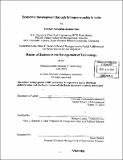| dc.contributor.advisor | Richard Locke. | en_US |
| dc.contributor.author | Venkatasubramaniam, Shivram, 1964- | en_US |
| dc.contributor.other | Massachusetts Institute of Technology. Management of Technology Program. | en_US |
| dc.coverage.spatial | a-ii--- | en_US |
| dc.date.accessioned | 2006-03-24T16:18:45Z | |
| dc.date.available | 2006-03-24T16:18:45Z | |
| dc.date.copyright | 2003 | en_US |
| dc.date.issued | 2003 | en_US |
| dc.identifier.uri | http://hdl.handle.net/1721.1/29720 | |
| dc.description | Thesis (S.M.M.O.T.)--Massachusetts Institute of Technology, Sloan School of Management, Management of Technology Program, 2003. | en_US |
| dc.description | Includes bibliographical references (leaves 62-63). | en_US |
| dc.description.abstract | Entrepreneurship, with all its attendant ingredients, is one of the best means of triggering economic and social development in developing countries like India. There are several staple and mandatory ingredients necessary for the nourishment of entrepreneurship such as capital, labor, management, and several others; and several milestones in the evolution of an entrepreneurial opportunity such as funding, recruitment, and so on. As entrepreneurship ideas and opportunities take form and substance, the prevailing process for entrepreneurship in a country results gradually guides an entrepreneur past numerous milestones. The value of entrepreneurship as an economic development tool lies in the compression and/or acceleration of the overall process of entrepreneurship in a country by providing pinpointed assistance in three areas viz. idea development, capital and skills procurement, and organizational growth. This is best achieved by an organizational entity committed to accelerating the entrepreneurship process. This thesis follows through on the above idea specifically in the context of India. India is a durable democracy with a long legacy and history of entrepreneurship dating back to the first century B.C. Modern India features political and economic policies that favour global trade and business, a reliable yet evolving regulatory and legal framework, a resilient financial system, an educated and English-speaking labor force that offers tremendous cost advantages and a growing educational infrastructure of education institutions that offer excellent higher education in technology and business. In summary, as developing countries go, India offers an excellent milieu for aspiring entrepreneurs. A summary country analysis detailing this forms the first part of the thesis. The thesis then identifies candidate business models that could effectively support the one-point agenda of catalyzing entrepreneurship. These four business models differ with respect to the organizational form of the entity concerned, the metrics for success, the measurement of the metrics, possible conflicts of interest, and the estimated overall risk of the venture in the Indian context. The most viable and effective business model is selected. Finally, the thesis builds on the model selected and presents a comprehensive business plan for accelerating entrepreneurship in India. | en_US |
| dc.description.statementofresponsibility | by Shivram Venkatasubramaniam. | en_US |
| dc.format.extent | 73 leaves | en_US |
| dc.format.extent | 2528473 bytes | |
| dc.format.extent | 2528280 bytes | |
| dc.format.mimetype | application/pdf | |
| dc.format.mimetype | application/pdf | |
| dc.language.iso | eng | en_US |
| dc.publisher | Massachusetts Institute of Technology | en_US |
| dc.rights | M.I.T. theses are protected by copyright. They may be viewed from this source for any purpose, but reproduction or distribution in any format is prohibited without written permission. See provided URL for inquiries about permission. | en_US |
| dc.rights.uri | http://dspace.mit.edu/handle/1721.1/7582 | |
| dc.subject | Management of Technology Program. | en_US |
| dc.title | Economic development through entrepreneurship in India | en_US |
| dc.type | Thesis | en_US |
| dc.description.degree | S.M.M.O.T. | en_US |
| dc.contributor.department | Management of Technology Program. | en_US |
| dc.contributor.department | Sloan School of Management | |
| dc.identifier.oclc | 54038286 | en_US |
